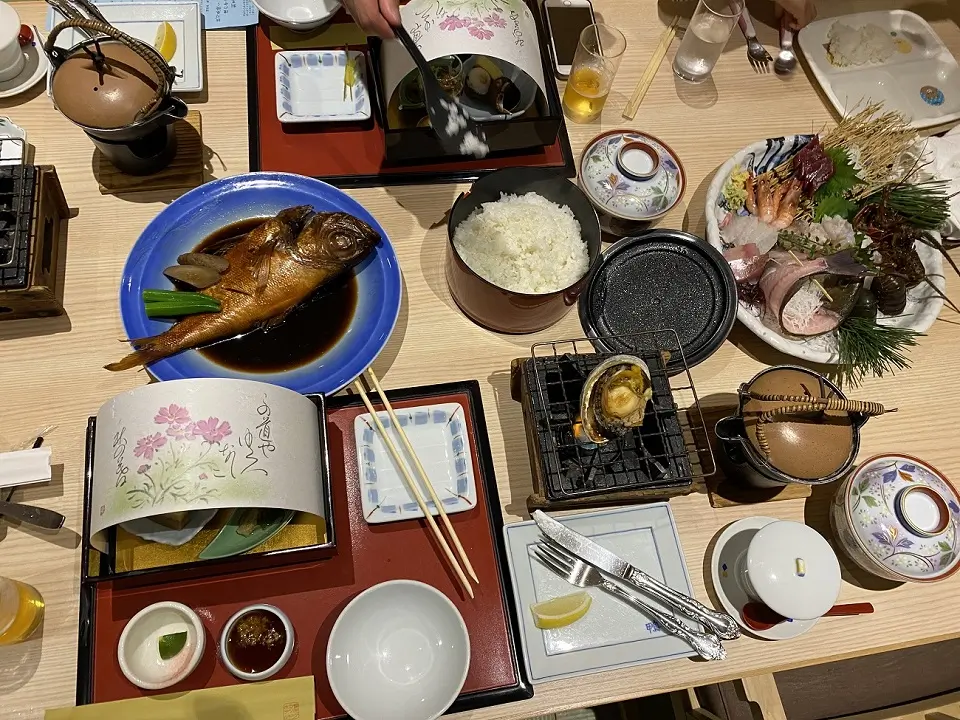Japanese Food and Eating Habits

Japanese food and eating habits are enviable because of the evident health consciousness they reflect. Japanese love to eat, and many Japanese people even travel to enjoy different kinds of food. However, the Japanese always take food not just as food but as a means to have a healthy life.
The Japanese diet typically consists of composed of fresh and unprocessed ingredients. Some main items in regular Japanese food are rice, cooked and pickled vegetables, fish, and meat.
Japan, an island nation with 6,852 islands, has more fish and other seafood in its day-to-day food. The Japanese diet is also famous for being quite healthy with low-fat and low-sugar ingredients. There are fried food items like tempura; however, Japanese people do not eat these food items regularly.
Furthermore, the Japanese also eat raw fish in sushi, sashimi, and many smoked, pickled, and fermented foods. While the big draw is ramen and sushi, many types of cuisine range from very traditional to international. In addition, there is a Western-influenced Japanese version called Yoshoku.
Japan does have fried food items and even sweets; however, as per normal eating habits, the Japanese eat such items only occasionally.
The type of food, ingredients, and cuisine in Japan also vary depending on the region. Let’s explore what basic Japanese cuisine is.
Japanese Cuisine
Japanese traditional cuisine is well balanced with many small dishes, such as Okazu and miso soup, which vary from household to region. Food ingredients, such as rice, soybeans, and miso, are essential to Japanese food.
Rice is the main dish, eaten with the side items. These items vary depending on the season. For example, in the summer, eggplant or Nasu is popular. Grilled Sanma fish is good in the fall, especially eaten during the early fall with Shinmai, meaning newly harvested rice.
Miso also varies, wherein Kyoto Miso soup is whiter and sweet; in Nagoya, it is red and saltier, but there are many other blends. The ingredients in the soup will vary, but typical is tofu, Wakame seaweed, and chopped spring onions.
A traditional simple breakfast is usually grilled salmon, rice, Otsukemono pickled vegetables, miso soup, and Nori dried seaweed with the rice.
There are many fermented food items in Japan. In the old days, fish would spoil when transported to the regions where they could not source fresh raw fish. Therefore, fish like Saba or mackerel were pickled in vinegar (Saba Sushi), which is still popular. Kyoto is famous for its pickles, and Mizu Nasu (water eggplant pickles) is delicious when eaten with rice.
Most Japanese people love Natto. Natto is a traditional Japanese food made from fermented soybeans. It has a unique, strong smell, a slimy texture, and a distinct, acquired taste that can be polarizing.
Natto is a rich source of protein, vitamins, and minerals, particularly vitamin K2, which is important for bone health. It also contains probiotics, which promote a healthy gut and immune system.
Other Japanese Favorites
Gyoza, tempura, and Unagi grilled eel are very popular in Japan, especially in the summer, as they bring you stamina. However, they can be very pricey.
Another favorite dish is Teishoku. Teishoku dining is based on the ichiju-issai (or “one soup, one side”). Teishoku is a traditional meal offered at Zen temples. It is one of the types of Japanese set meals available in Japanese restaurants.
In Teishoku, all the course dishes are served together as a set. These dishes include a main dish, soup, rice, and pickles. Over time, this became one of the favorites throughout Japan and became one of the common meal sets served at restaurants and cafeterias.
The main dishes for teishoku can be tonkatsu (pork cutlet), yakizakana (grilled fish), and tempura (deep-fried battered fish and vegetables). These main dishes are served on a tray along with a bowl of rice, a bowl of miso soup, and various side dishes known as souzai. These side dishes can be salads and Japanese pickles.
The Teishoku with pork has the main dish as Hambagu (hamburger). It is served on a hot plate with demi-glaze sauce or soy-based with grated radish.
Another delicacy is Napolitan spaghetti, a tomato ketchup-based pasta, which many refer to as Mukashi Nagara No Aji (taste from the past).
Other common favorite foods are curry-rice, tonkatsu, kara age fried chicken pieces. Though smaller than the American version, Shoga Yaki sliced pork sautéed in a ginger-based sauce served with shredded cabbage is also a common favorite. Countless restaurants serve different variations, which are common at golf and ski resorts and in bento boxes. These are common comfort foods that Japanese people eat out or at home with their family.
Region Wise Most Famous Foods in Japan
Every region in Japan has its special delicacies. Moreover, you can have the real taste of these famous food items only in those specific parts of Japan.
Even native Japanese keep eating those famous regional dishes on their bucket list while traveling to those specific areas of Japan.
List of Famous Dishes of Every Prefecture of Japan
- Hokkaido: Seafood (crab, scallops, sea urchin, salmon), Soup Curry, Genghis Khan (Jingisukan), soft serve ice cream
- Aomori: Apple, Miso Curry Milk Ramen, Senbei Jiru
- Iwate: Wanko Soba, Morioka Reimen, Morioka Jajamen
- Miyagi: Gyutan (beef tongue), Zunda Mochi, Sendai Sushi
- Akita: Kiritanpo, Inaniwa Udon
- Yamagata: Yonezawa Beef, Sakuranbo (cherries), Imoni
- Fukushima: Kitakata Ramen, Aizuwakamatsu Sauce Katsudon
- Ibaraki: Natto (fermented soybeans), Anko Nabe (anglerfish hot pot)
- Tochigi: Gyoza, Sano Ramen
- Gunma: Mizusawa Udon, Yaki Manju
- Saitama: Hiyajiru Udon
- Chiba: Namerou (raw fish dish), Peanuts, Funabashi Sanma Men
- Tokyo: Monjayaki, Sushi, Soba, Tempura
- Kanagawa: Shonan Shirasu (whitebait), Yokohama Ramen
- Niigata: Koshihikari Rice, Sasa Dango, Noppei Jiru
- Toyama: Toyama Black Ramen, White Shrimp, Masu-zushi
- Ishikawa: Kaga Ryori (traditional cuisine), Noto Donburi
- Fukui: Echizen Crab, Soba, Sauce Katsudon
- Yamanashi: Houtou (noodle soup), Koshu Wine, Fujinomiya Yakisoba
- Nagano: Soba, Shinshu Miso, Oyaki (dumplings)
- Gifu: Hida Beef, Gohei Mochi, Kei-chan (chicken dish)
- Shizuoka: Unagi (eel), Shizuoka Oden, Sakura Ebi
- Aichi: Miso Katsu, Hitsumabushi (grilled eel on rice), Nagoya Cochin Chicken
- Mie: Matsusaka Beef, Ise Udon, Tekone Sushi
- Shiga: Omi Beef, Funazushi (fermented sushi), Biwa Trout
- Kyoto: Kaiseki Ryori (traditional multi-course meal), Yuba, Matcha Sweets
- Osaka: Okonomiyaki, Takoyaki, Kushikatsu
- Hyogo: Kobe Beef, Akashi Yaki, Tako Yaki
- Nara: Kakinoha-zushi (sushi wrapped in persimmon leaves), Miwa Somen, Narazuke (pickles)
- Wakayama: Kishu Umeboshi (pickled plums), Wakayama Ramen, Mikan (mandarin oranges)
- Tottori: Matsuba Crab, Daisen Chicken, Tottori Curry Udon
- Shimane: Izumo Soba, Shijimi Clam Miso Soup, Taimeshi (sea bream rice)
- Okayama: Barazushi, Kibi Dango, Mamakari-zushi 34
- Hiroshima: Okonomiyaki, Hiroshima-style; Oysters; Momiji Manju
- Yamaguchi: Fugu (blowfish); Kawara Soba; Kintsuba
- Tokushima: Sudachi (citrus fruit); Tokushima Ramen; Naruto Kintoki (sweet potato)
- Kagawa: Sanuki Udon; Shippoku Ryori (multi-course meal); Olive Wagyu
- Ehime: Jakoten (fried fish cake); Mikan (mandarin oranges); Tai-meshi (sea bream rice)
- Kochi: Katsuo no Tataki (seared bonito); Sawachi Ryori (platter dish); Tosa Sushi
- Fukuoka: Hakata Ramen; Mentaiko (spicy cod roe); Mizutaki (chicken hot pot)
- Saga: Saga Beef; Takezaki Crabs; Yobuko Squid
- Nagasaki: Chanpon (noodle dish); Nagasaki Castella (sponge cake); Sara Udon
- Kumamoto: Basashi (raw horse meat); Kumamoto Ramen; Karashi Renkon (lotus root with mustard)
- Oita: Toriten (fried chicken); Bungo Beef; Seki Saba (mackerel) and Seki Aji (horse mackerel)
- Miyazaki: Miyazaki Jitokko Chicken; Hyuga Sumo Udon; Mango
- Kagoshima: Kurobuta Pork; Satsuma Age (fried fish cake); Kibinago (silver-stripe herring)
- Okinawa: Goya Champuru (bitter melon stir-fry); Rafute (Okinawan braised pork belly); Soki Soba (noodles with pork ribs)
Food in Japanese Department Stores
Depachika (Department Store + Chika), meaning the basement floors of department stores, sell food. The food selection in these big department stores is endless. You can buy readymade food items by weight and a selection of meats, fish, and vegetables.
The choice of sweets on offer is also vast and varied, from traditional Wagashi Japanese sweets such as strawberries wrapped in mochi or red bean paste to cakes, puddings, pies, and candies worldwide.
Sharing Food with Family & Friends
In America, individuals usually have their plate, and while there is occasional sharing, such as telling your friend to “try this. It’s delicious,” people will have their serving. This is also true in Japan, but sharing or eating from the same pot is common.
However, Nabe and Shabu Shabu are shared from the same pot. All ingredients are added to the broth, and everyone will put what they like from the pot into their bowl. In the end, rice or noodles are added.
Out of politeness, someone usually serves the people at the table from the common pot. Other such examples are Monjayaki and Okonomi Yaki. These are batter-based pancakes with various ingredients cooked on a Teppan in the middle of the table. Once ready to eat, everyone eats these with their mini spatula, similar to sharing a pizza.
Growing up in a Japanese household and visiting in the summer from America, without a doubt, I have my favorite comfort foods from both countries. Having moved back to Tokyo twenty years ago, access to good Japanese food and varied cuisine is very convenient.
It’s not just what’s popular worldwide, including ramen, sushi, Kobe, and good wagyu beef. Japan is a food culture, and there is always a very wide selection. You won’t run out of choices and will always find some new Japanese delicacies to try and enjoy! Moreover, following Japanese eating habits is great for health and energy levels.


Native Japanese raised in the USA, Yoshinobu Takaoka returned to Japan 20 years back and is a senior finance professional with over 20 years of working experience in Japan. While being Japanese, Yoshinobu has a deep understanding of Japan and Japanese customs, growing up in the U.S. he also has a deep understanding of western culture and what makes foreigners curious about Japan.

